stop start MITSUBISHI OUTLANDER 2020 (in English) User Guide
[x] Cancel search | Manufacturer: MITSUBISHI, Model Year: 2020, Model line: OUTLANDER, Model: MITSUBISHI OUTLANDER 2020Pages: 443, PDF Size: 60.03 MB
Page 148 of 443
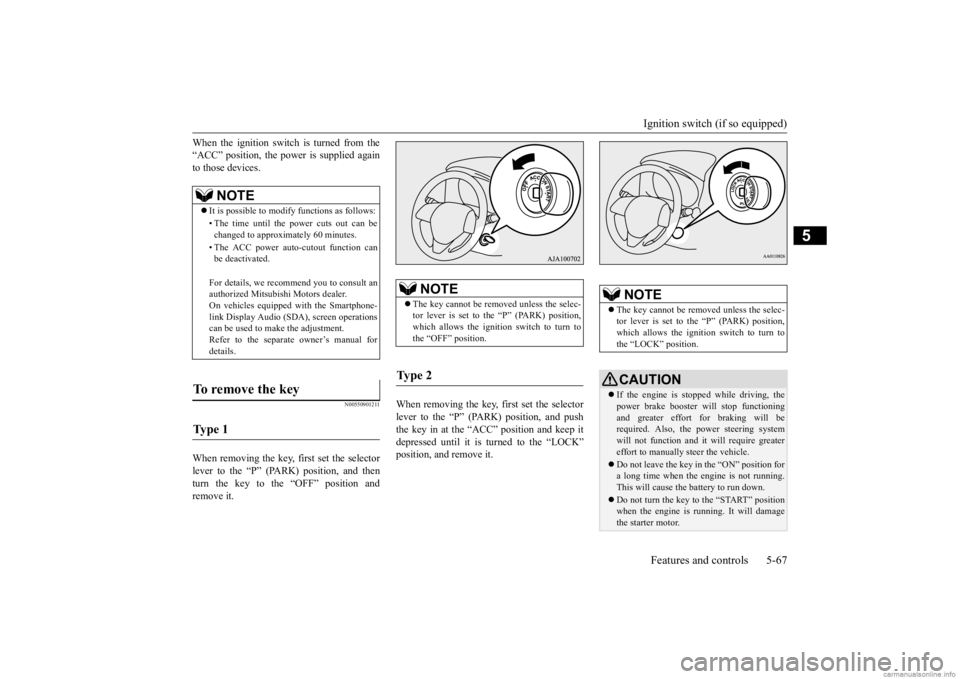
Ignition switch (if so equipped) Features and controls 5-67
5
When the ignition switch is turned from the “ACC” position, the pow
er is supplied again
to those devices.
N00550901211
When removing the key, first set the selectorlever to the “P” (PARK) position, and thenturn the key to the “OFF” position and remove it.
When removing the key,
first set the selector
lever to the “P” (PARK) position, and push the key in at the “ACC” position and keep it depressed until it is turned to the “LOCK”position, and remove it.
NOTE
It is possible to modify functions as follows: • The time until the power cuts out can be changed to approxi
mately 60 minutes.
• The ACC power auto-c
utout function can
be deactivated. For details, we reco
mmend you to consult an
authorized Mitsubish
i Motors dealer.
On vehicles equipped with the Smartphone- link Display Audio (SDA), screen operations can be used to make the adjustment.Refer to the separate owner’s manual for details.
To remove the key
Ty p e 1
NOTE
The key cannot be rem
oved unless the selec-
tor lever is set to the “P” (PARK) position,which allows the ignition switch to turn to the “OFF” position.
Ty p e 2
NOTE
The key cannot be rem
oved unless the selec-
tor lever is set to the “P” (PARK) position, which allows the ignition switch to turn tothe “LOCK” position.CAUTION If the engine is stopped while driving, the power brake booster will stop functioning and greater effort for braking will be required. Also, the power steering systemwill not function and it
will require greater
effort to manually steer the vehicle. Do not leave the key in
the “ON” position for
a long time when the engine is not running. This will cause the
battery to run down.
Do not turn the key to the “START” position when the engine is r
unning. It will damage
the starter motor.
BK0278200US.book 67 ページ 2019年4月10日 水曜日 午前10時59分
Page 154 of 443
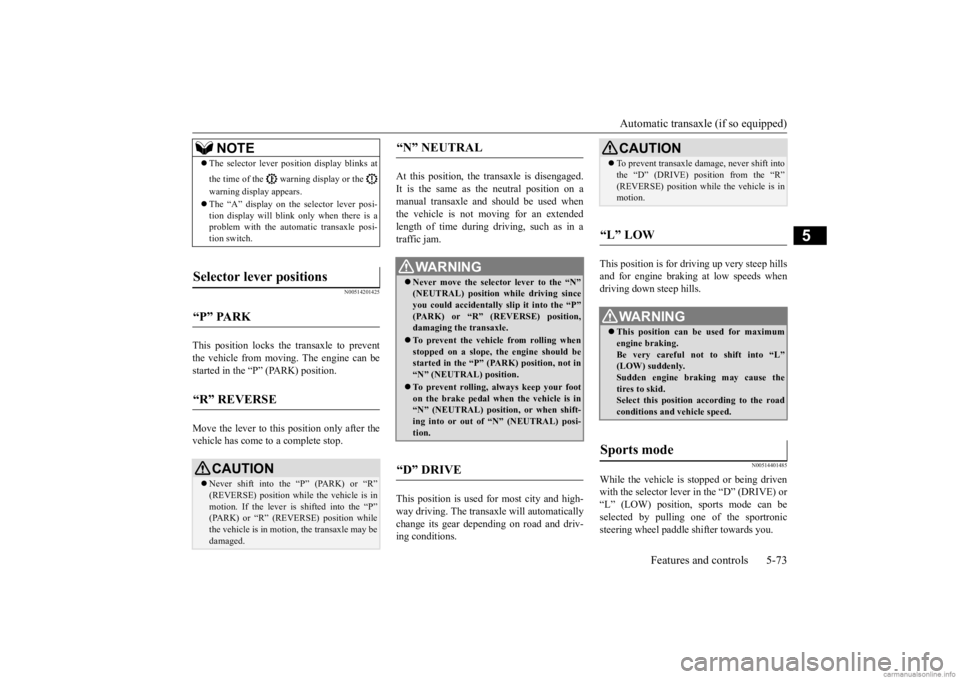
Automatic transaxle (if so equipped)
Features and controls 5-73
5
N00514201425
This position locks the transaxle to prevent the vehicle from moving.
The engine can be
started in the “P” (PARK) position. Move the lever to this position only after the vehicle has come to a complete stop.
At this position, the transaxle is disengaged. It is the same as the neutral position on a manual transaxle and should be used whenthe vehicle is not m
oving for an extended
length of time during driving, such as in a traffic jam. This position is used for most city and high- way driving. The transaxle will automatically change its gear depe
nding on road and driv-
ing conditions.
This position is for dr
iving up very steep hills
and for engine braking at low speeds when driving down steep hills.
N00514401485
While the vehicle is stopped or being driven with the selector lever in the “D” (DRIVE) or“L” (LOW) position, sports mode can be selected by pulling one of the sportronic steering wheel paddle shifter towards you.
NOTE
The selector lever posi
tion display blinks at
the time of the warning display or the warning display appears. The “A” display on the selector lever posi- tion display will blink only when there is a problem with the automatic transaxle posi- tion switch.
Selector lever positions
“P” PARK
“R” REVERSE
CAUTION Never shift into the “P” (PARK) or “R” (REVERSE) position while the vehicle is in motion. If the lever is shifted into the “P” (PARK) or “R” (REVERSE) position whilethe vehicle is in moti
on, the transaxle may be
damaged.
“N” NEUTRAL
WA R N I N G Never move the selector lever to the “N” (NEUTRAL) position while driving since you could accidentally slip it into the “P” (PARK) or “R” (REVERSE) position,damaging the transaxle. To prevent the vehicle from rolling when stopped on a slope,
the engine should be
started in the “P” (PARK) position, not in “N” (NEUTRAL) position. To prevent rolling, always keep your foot on the brake pedal when the vehicle is in“N” (NEUTRAL) positi
on, or when shift-
ing into or out of
“N” (NEUTRAL) posi-
tion.
“D” DRIVE
CAUTION To prevent transaxle damage, never shift into the “D” (DRIVE) position from the “R”(REVERSE) position while the vehicle is inmotion.
“L” LOW
WA R N I N G This position can be used for maximum engine braking.Be very careful not to shift into “L” (LOW) suddenly. Sudden engine braking may cause thetires to skid. Select this position according to the road conditions and vehicle speed.
Sports mode
BK0278200US.book 73 ページ 2019年4月10日 水曜日 午前10時59分
Page 157 of 443
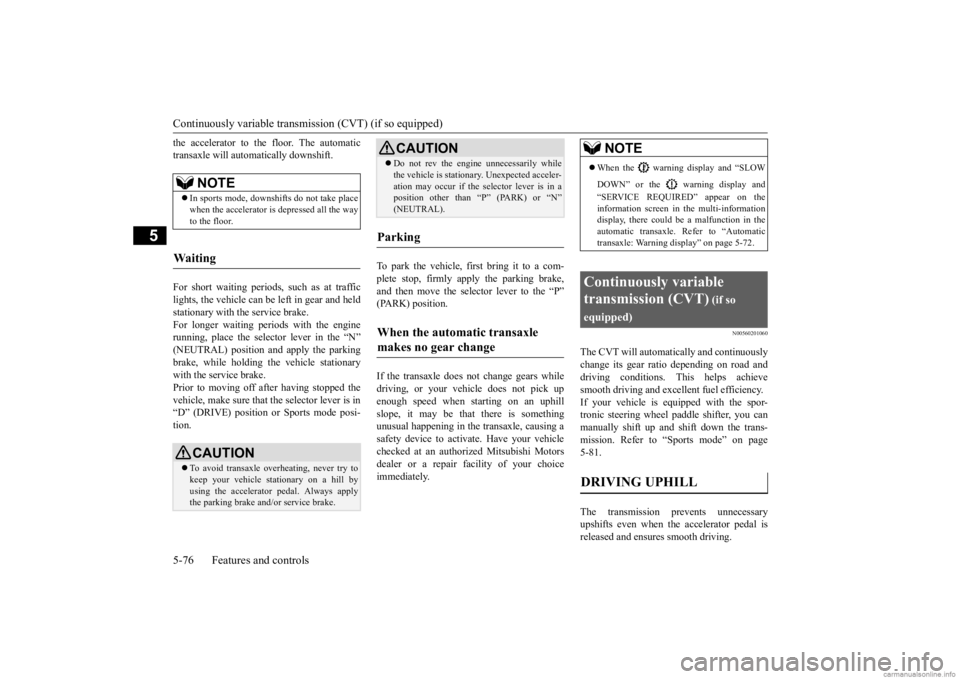
Continuously variable transmission (CVT) (if so equipped) 5-76 Features and controls
5
the accelerator to the floor. The automatic transaxle will automatically downshift. For short waiting periods, such as at traffic lights, the vehicle can be
left in gear and held
stationary with the service brake. For longer waiting periods with the engine running, place th
e selector lever in the “N”
(NEUTRAL) position a
nd apply the parking
brake, while holding the vehicle stationary with the service brake.Prior to moving off after having stopped the vehicle, make sure that
the selector lever is in
“D” (DRIVE) position or
Sports mode posi-
tion.
To park the vehicle, fi
rst bring it to a com-
plete stop, firmly apply the parking brake, and then move the sele
ctor lever to the “P”
(PARK) position. If the transaxle does not change gears while driving, or your vehicle does not pick upenough speed when starting on an uphill slope, it may be that there is something unusual happening in the transaxle, causing asafety device to activa
te. Have your vehicle
checked at an authorized Mitsubishi Motors dealer or a repair facility of your choiceimmediately.
N00560201060
The CVT will automati
cally and continuously
change its gear ratio depending on road anddriving conditions. This helps achieve smooth driving and excellent fuel efficiency. If your vehicle is equipped with the spor-tronic steering wheel paddle shifter, you can manually shift up and shift down the trans- mission. Refer to “Sports mode” on page5-81. The transmission prevents unnecessary upshifts even when the accelerator pedal is released and ensures smooth driving.
NOTE
In sports mode, downshifts do not take place when the accelerator is depressed all the way to the floor.
Waiting
CAUTION To avoid transaxle over
heating, never try to
keep your vehicle stat
ionary on a hill by
using the accelerator
pedal. Always apply
the parking brake and/or service brake.
Do not rev the engine unnecessarily while the vehicle is stationary. Unexpected acceler-ation may occur if the se
lector lever is in a
position other than “P” (PARK) or “N” (NEUTRAL).
Parking
When the automatic transaxle makes no gear change
CAUTION
NOTE
When the warning display and “SLOW DOWN” or the wa
rning display and
“SERVICE REQUIRED” appear on the information screen in the multi-informationdisplay, there could be
a malfunction in the
automatic transaxle. Refer to “Automatic transaxle: Warning di
splay” on page 5-72.
Continuously variable transmission (CVT)
(if so
equipped)DRIVING UPHILL
BK0278200US.book 76 ページ 2019年4月10日 水曜日 午前10時59分
Page 160 of 443

Continuously variable transmission (CVT) (if so equipped)
Features and controls 5-79
5
N00560401134
When the ignition switch is turned to the “ON” position or the operation mode is put in ON, the selector lever position is shown onthe multi-information display.
N00582900031
If the ambient temperature is low, the selectorlever position display on the multi informa-
tion display may blink when the selector lever is placed in the “D” (DRIVE), “Ds”(DOWNSHIFT & SPORTY DRIVING), “L” (LOW) or “R” (REVERSE) position immedi- ately after the engine has been started. Thisindicates that the transmission requires warm- ing up. While the display is blinking, the vehicle will not move, because the transmis-sion keeps disengaging until the warm up is completed even if the selector lever is placed in the “D”, “Ds”, “L” or “R” position. When the selector lever position display is blinking, perform the following procedure: 1. Depress the brake pedal with your right foot and place the se
lector lever in the
“N” (NEUTRAL) position for several seconds. 2. Keep depressing the brake pedal and thenplace the selector lever in the “D” (DRIVE), “Ds” (DOWNSHIFT & SPORTY DRIVING), “L” (LOW) or “R”(REVERSE) position. If
the selector lever
position display stops
blinking, the warm
up is completed and the transmission willfunction normally. 3. If the display is still
blinking, repeat steps
1 and 2 above.
N00560501164
or
When the warning display or the warn- ing display appears on
the information screen
in the multi-information display while you are driving, there could be a malfunction inthe CVT.
Selector lever position display
When the selector lever position display blinks
WA R N I N G To avoid unintended
vehicle movement,
keep brake pedal applied with your right foot and do not depress the acceleratorpedal, while the selector lever position dis- play is blinking.
NOTE
While the selector le
ver position display is
blinking, a buzzer will
sound intermittently.
Warning display
CAUTIONIf a malfunction occurs in the CVT while driving, the warning display or the warning display will appear on the informa- tion screen in the multi-information display. In this case, follow
these procedures:
[When warning di
splay is showing]
The continuously variable transmission (CVT) fluid is overhea
ting. The engine con-
trol may activate to
lower the CVT fluid tem-
perature, causing the e
ngine revolutions and
vehicle speed to decrea
se, In this case, take
one of the following procedures.• Slow down your vehicle.
BK0278200US.book 79 ページ 2019年4月10日 水曜日 午前10時59分
Page 161 of 443
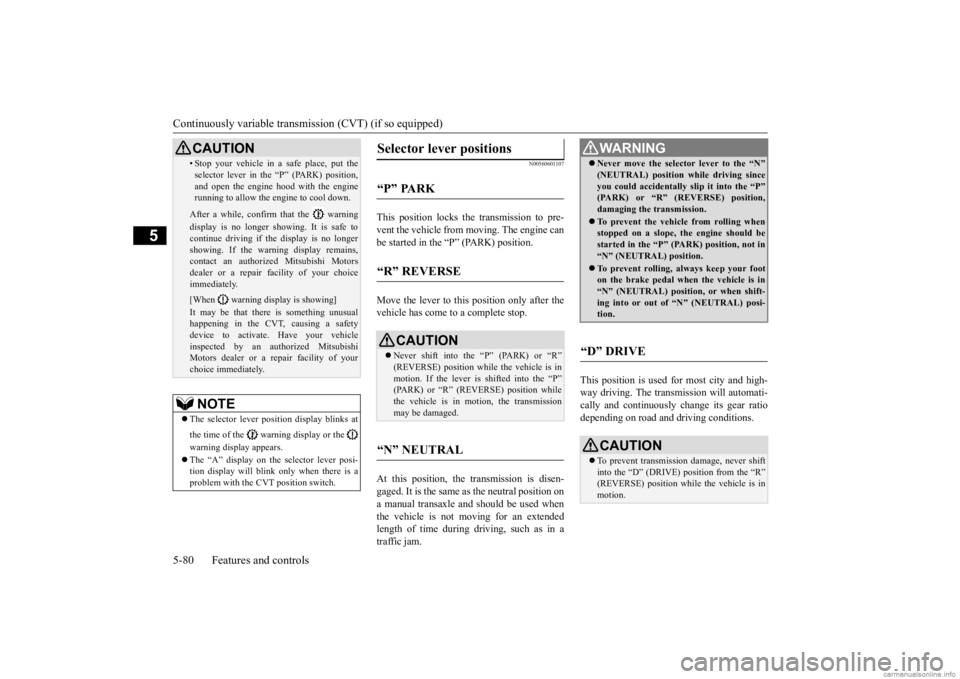
Continuously variable transmission (CVT) (if so equipped) 5-80 Features and controls
5
N00560601107
This position locks the transmission to pre- vent the vehicle from m
oving. The engine can
be started in the “P” (PARK) position. Move the lever to this position only after the vehicle has come to a complete stop. At this position, the
transmission is disen-
gaged. It is the same
as the neutral position on
a manual transaxle and should be used when the vehicle is not moving for an extended length of time during driving, such as in atraffic jam.
This position is used for most city and high- way driving. The transmission will automati- cally and continuously
change its gear ratio
depending on road a
nd driving conditions.
• Stop your vehicle in a
safe place, put the
selector lever in the “P” (PARK) position,and open the engine hood with the enginerunning to allow the engine to cool down.After a while, confirm that the warning display is no longer showing. It is safe to continue driving if the display is no longershowing. If the warning display remains, contact an authorized Mitsubishi Motors dealer or a repair fa
cility of your choice
immediately. [When warning display is showing] It may be that there is something unusual happening in the CVT, causing a safety device to activate
. Have your vehicle
inspected by an authorized Mitsubishi Motors dealer or a re
pair facility of your
choice immediately. NOTE
The selector lever posit
ion display blinks at
the time of the warning display or the warning display appears. The “A” display on the
selector lever posi-
tion display will blink only when there is a problem with the CV
T position switch.
CAUTION
Selector lever positions
“P” PARK
“R” REVERSE
CAUTIONNever shift into the “P” (PARK) or “R” (REVERSE) position while the vehicle is in motion. If the lever is shifted into the “P” (PARK) or “R” (REVERSE) position whilethe vehicle is in motion, the transmission may be damaged.
“N” NEUTRAL
WA R N I N G Never move the selector lever to the “N” (NEUTRAL) position while driving sinceyou could accidentally
slip it into the “P”
(PARK) or “R” (REVERSE) position, damaging the transmission. To prevent the vehicle from rolling when stopped on a slope,
the engine should be
started in the “P” (P
ARK) position, not in
“N” (NEUTRAL) position. To prevent rolling, always keep your foot on the brake pedal when the vehicle is in “N” (NEUTRAL) positi
on, or when shift-
ing into or out of
“N” (NEUTRAL) posi-
tion.
“D” DRIVE
CAUTION To prevent transmissi
on damage, never shift
into the “D” (DRIVE) position from the “R” (REVERSE) position while the vehicle is in motion.
BK0278200US.book 80 ページ 2019年4月10日 水曜日 午前10時59分
Page 164 of 443
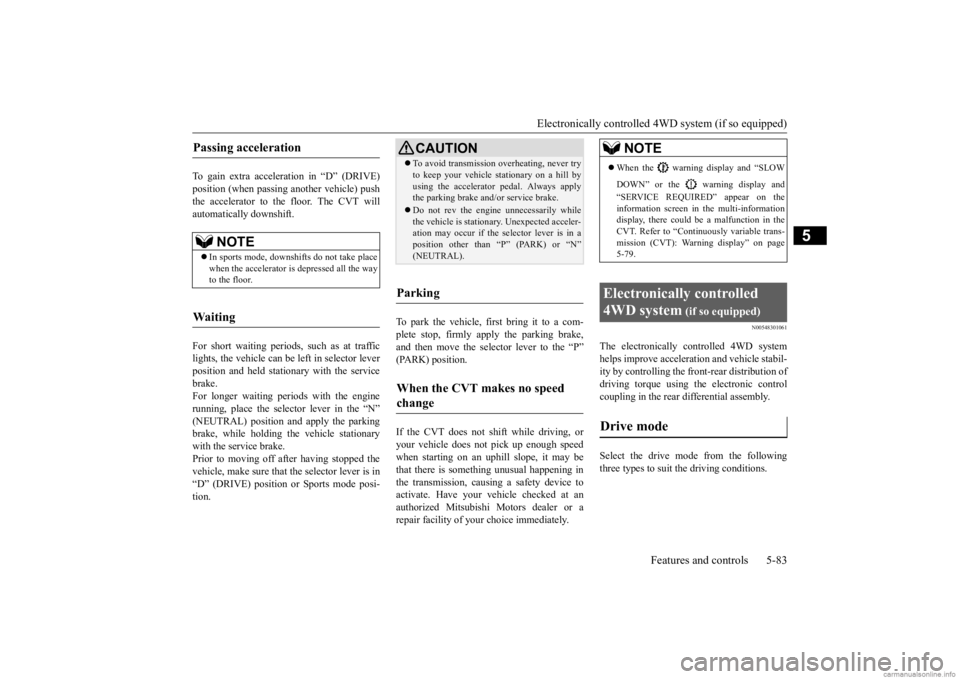
Electronically controlled 4WD system (if so equipped)
Features and controls 5-83
5
To gain extra acceleration in “D” (DRIVE) position (when passing another vehicle) push the accelerator to the floor. The CVT willautomatically downshift. For short waiting periods, such as at traffic lights, the vehicle can be
left in selector lever
position and held stationary with the service brake.For longer waiting periods with the engine running, place th
e selector lever in the “N”
(NEUTRAL) position and apply the parkingbrake, while holding th
e vehicle stationary
with the service brake. Prior to moving off after having stopped thevehicle, make sure that the selector lever is in “D” (DRIVE) position or Sports mode posi- tion.
To park the vehicle, first bring it to a com- plete stop, firmly apply the parking brake, and then move the selector lever to the “P” (PARK) position. If the CVT does not shift while driving, or your vehicle does not pick up enough speed when starting on an uphill slope, it may bethat there is something unusual happening in the transmission, causi
ng a safety device to
activate. Have your ve
hicle checked at an
authorized Mitsubishi Motors dealer or a repair facility of your choice immediately.
N00548301061
The electronically c
ontrolled 4WD system
helps improve accelerati
on and vehicle stabil-
ity by controlling the front-rear distribution ofdriving torque using the electronic control coupling in the rear differential assembly. Select the drive mode from the following three types to suit the driving conditions.
Passing acceleration
NOTE
In sports mode, downshi
fts do not take place
when the accelerator is depressed all the wayto the floor.
Waiting
CAUTION To avoid transmission
overheating, never try
to keep your vehicle st
ationary on a hill by
using the accelerator
pedal. Always apply
the parking brake and/or service brake. Do not rev the engine unnecessarily while the vehicle is stationary. Unexpected acceler- ation may occur if the selector lever is in a position other than “P” (PARK) or “N”(NEUTRAL).
Parking
When the CVT makes no speed change
NOTE
When the warning display and “SLOW DOWN” or the warning display and “SERVICE REQUIRED” appear on the information screen in
the multi-information
display, there could be
a malfunction in the
CVT. Refer to “Continuously variable trans- mission (CVT): Warning display” on page5-79.
Electronically controlled 4WD system
(if so equipped)
Drive mode
BK0278200US.book 83 ページ 2019年4月10日 水曜日 午前10時59分
Page 170 of 443

4-wheel drive operation
Features and controls 5-89
5
tion when driving on sl
ippery, wet or snow-
covered roads and when moving out of mud.But it is not suitable
for heavy off road use or
towing in rough conditions. It is particularly im
portant to note that 4-
wheel drive may not give sufficient hill climbing ability and engine braking on steep slopes. You should try to avoid driving onsteep slopes. Also, you must exercise caution when driving on sand and mud and when driving through water because sufficie
nt traction may not be
available in certain circumstances.Please avoid driving the vehicle through areas where the tires may get stuck in deep sand or mud.
When turning a sharp corner in “4WD LOCK” (Electronically controlled 4WD) or“GRAVEL” (S-AWC) position at low speed, a slight difference in
steering may be experi-
enced similar to feeling as if the brakes wereapplied. This is called tight corner braking and results from each of the four tires being at a different distance from the corner. The phe-nomenon is typical of 4-wheel drive vehicles. If this occurs, either straighten out the steer- ing wheel or change to another mode. Set the drive mode-selector to “4WD AUTO”, “4WD LOCK” (Electronically con-trolled 4WD) or “SNOW” (S-AWC) in accor- dance with the road conditions, and then gradually depress the ac
celerator pedal for a
smooth start.
WA R N I N G Do not over-rely on th
e 4-wheel drive vehi-
cles. Even 4-wheel drive vehicles have lim- its to the system and ability to maintaincontrol and traction.
Reckless driving may
lead to accidents. Always drive carefully, taking account of the road conditions. Improperly operating
this vehicle on or
off-pavement can cause an accident orrollover in which you
and your passengers
could be seriously
injured or killed.
• Follow all instructions and guidelines in the owner’s manual.• Keep your speed low and do not drivefaster than conditions.
NOTE
Driving on rough roads can be hard on a vehicle. Before you le
ave the pavement, be
sure all scheduled ma
intenance and service
has been done, and that
you have inspected
your vehicle. Pay spec
ial attenti
on to the
condition of the tires, a
nd check the tire pres-
sures. Mitsubishi Motors is not
responsible to the
operator for any damage or injury caused or liability incurred by improper and negligent operation of a vehicl
e. All techniques of
vehicle operation depe
nd on the skill and
experience of the oper
ator and other partici-
pating parties. Any de
viation from the rec-
ommended operating instru
ctions above is at
their own risk. Note that the stopping distance required of the 4-wheel drive vehicl
e differs very little
from that of the front-wheel drive vehicle.When driving on a snow-covered road or a slippery, muddy surface,
make sure that you
keep a sufficient dist
ance between your vehi-
cle and the one ahead of you. The driving posture should be more upright; adjust the seat to a good position for easy steering and pedal operati
on. Be sure to wear
the seat belt. After driving on rough roads, check each part of the vehicle and wash it thoroughlywith water. Refer to the “Inspection and maintenance following rough road opera- tion” section and “Vehic
le care and Mainte-
nance” sections.
CAUTION Setting the drive mode-selector to “4WD LOCK” (Electronically
controlled 4WD) or
“GRAVEL” (S-AWC) position to drive ondry paved road will in
crease fuel consump-
tion, with possible
noise generation.
Turning sharp corners On snowy or icy roads
BK0278200US.book 89 ページ 2019年4月10日 水曜日 午前10時59分
Page 175 of 443

Brake auto hold (if so equipped) 5-94 Features and controls
5
If the brake auto hold switch is pressed while all of the following conditions are met, the system will change to the standby state and the indicator light (A) on the switch comeson. The ignition switch or
the operation mode
in ON. The driver’s seat belt is fastened. The driver’s door is closed.
When the vehicle is
stopped by depressing
the brake pedal with the selector lever in any position other than “P” (PARK) or “R”(REVERSE), the brake auto hold activates and the vehicle will be
held stationary.
The brake auto hold indicator light in theinstrument cluster will come on while the system activates.
How to use brake auto hold
To turn on brake auto hold
NOTE
When the brake auto hold system cannot be used, a buzzer will sound and the following warning will appear on the information screen in the multi information display.
• If this warning appear
s, confirm that all of
the conditions for system operation are metand that there is no malfunction in the sys-tem. • If this warning appear
s, fasten the driver’s
seat belt.
If any of the following occur while the sys- tem is standby state, the brake auto hold sys-tem will be turned off automatically and the indicator light on the switch goes off. A buzzer will sound a
nd the message will
appear on the information screen in the multi information display. • When the driver’s seat
belt is unfastened.
• When the driver’s door is opened.• When there is a malfunction in the systemNOTE
If keeping pressing the brake auto hold switch after setting
the brake auto hold to
ON (stand by), the brake auto hold willreturn to OFF as a protection function is operated. After returning to OFF, the brake auto holdwill not be switched to
ON (Stand by) even if
the brake auto hold switch is pressed. To set the brake auto hold to
ON, restart the engine
and press the brake auto hold switch again.
To activate brake auto hold
NOTE
or
BK0278200US.book 94 ページ 2019年4月10日 水曜日 午前10時59分
Page 176 of 443
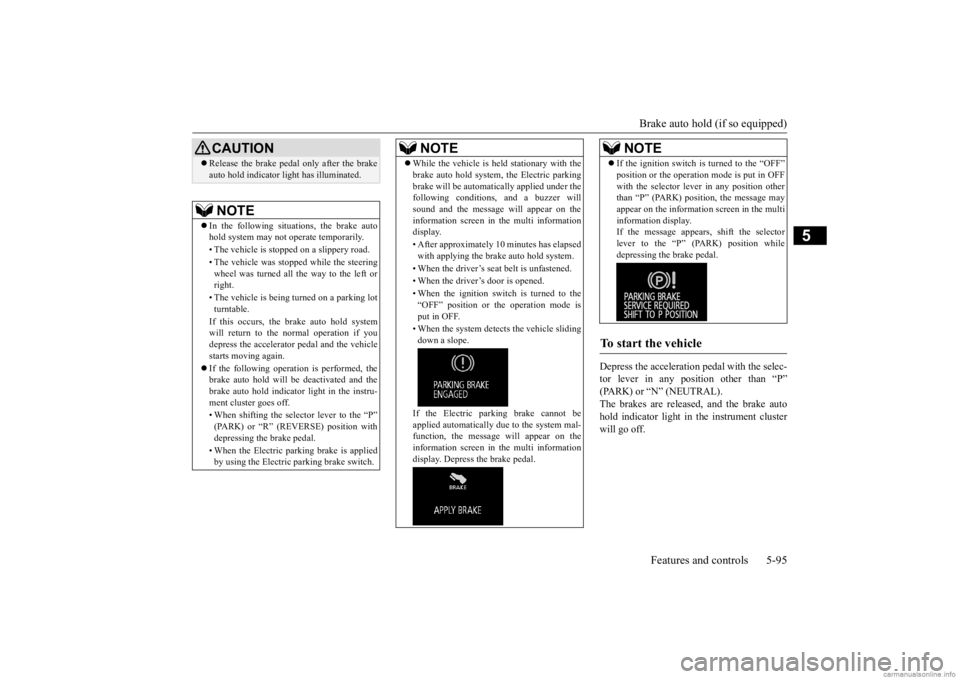
Brake auto hold (if so equipped)
Features and controls 5-95
5
Depress the acceleration
pedal with the selec-
tor lever in any position other than “P” (PARK) or “N” (NEUTRAL). The brakes are released, and the brake autohold indicator light in
the instrument cluster
will go off.
CAUTION Release the brake pedal only after the brake auto hold indicator li
ght has illuminated.
NOTE
In the following situations, the brake auto hold system may not
operate temporarily.
• The vehicle is stoppe
d on a slippery road.
• The vehicle was stoppe
d while the steering
wheel was turned all the way to the left or right. • The vehicle is being turned on a parking lot turntable. If this occurs, the brake auto hold system will return to the normal operation if youdepress the accelerator
pedal and the vehicle
starts moving again. If the following operation is performed, the brake auto hold will be
deactivated and the
brake auto hold indicator light in the instru-ment cluster goes off. • When shifting the selector lever to the “P” (PARK) or “R” (REVERSE) position with depressing the brake pedal. • When the Electric park
ing brake is applied
by using the Electric
parking brake switch.
While the vehicle is held stationary with the brake auto hold system, the Electric parkingbrake will be automati
cally applied under the
following conditions, and a buzzer will sound and the message will appear on the information screen in the multi informationdisplay. • After approximately 10 minutes has elapsed with applying the brake auto hold system. • When the driver’s seat
belt is unfastened.
• When the driver’s door is opened. • When the ignition switch is turned to the “OFF” position or th
e operation mode is
put in OFF. • When the system detect
s the vehicle sliding
down a slope. If the Electric park
ing brake cannot be
applied automatically due to the system mal- function, the message
will appear on the
information screen in the multi informationdisplay. Depress the brake pedal.NOTE
If the ignition switch is turned to the “OFF” position or the operation mode is put in OFFwith the selector leve
r in any position other
than “P” (PARK) position, the message may appear on the information screen in the multi information display.If the message appears, shift the selector lever to the “P” (PARK) position while depressing the brake pedal.
To start the vehicle
NOTE
BK0278200US.book 95 ページ 2019年4月10日 水曜日 午前10時59分
Page 177 of 443
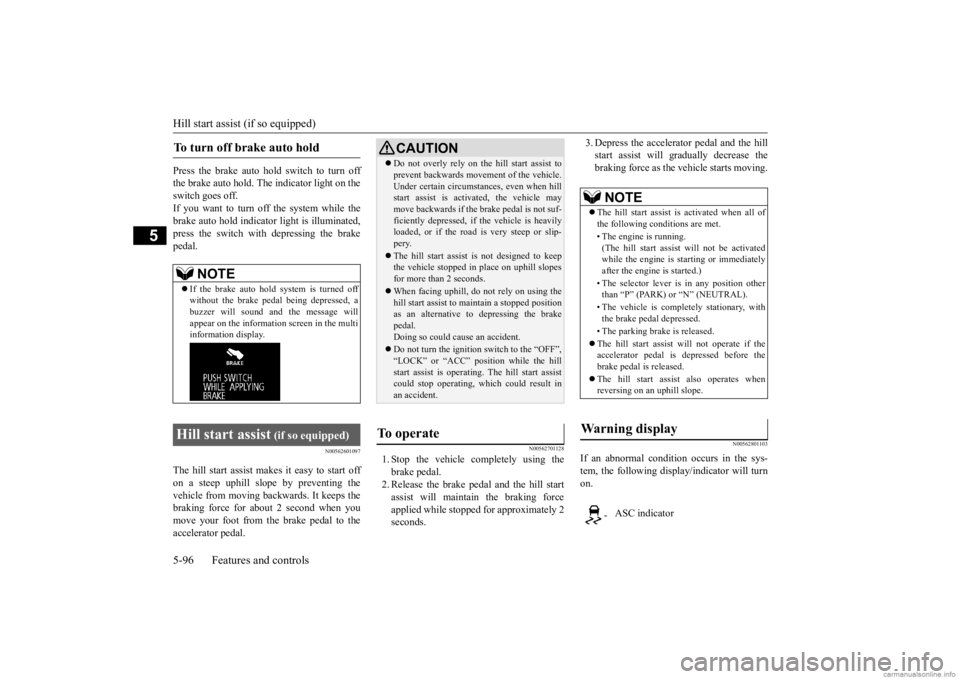
Hill start assist (if so equipped) 5-96 Features and controls
5
Press the brake auto hold switch to turn off the brake auto hold. The indicator light on the switch goes off. If you want to turn off the system while thebrake auto hold indicator light is illuminated, press the switch with
depressing the brake
pedal.
N00562601097
The hill start assist makes it easy to start off on a steep uphill sl
ope by preventing the
vehicle from moving backwards. It keeps thebraking force for about 2 second when you move your foot from the brake pedal to the accelerator pedal.
N00562701128
1. Stop the vehicle completely using the brake pedal. 2. Release the brake pedal and the hill startassist will maintain the braking force applied while stopped
for approximately 2
seconds.
3. Depress the accelera
tor pedal and the hill
start assist will gr
adually decrease the
braking force as the vehicle starts moving.
N00562801103
If an abnormal condition occurs in the sys-tem, the following display/indicator will turnon.
To turn off brake auto hold
NOTE
If the brake auto hold system is turned off without the brake peda
l being depressed, a
buzzer will sound and the message will appear on the information screen in the multiinformation display.
Hill start assist
(if so equipped)
CAUTION Do not overly rely on the hill start assist to prevent backwards movement of the vehicle.Under certain circumstances, even when hillstart assist is activated, the vehicle may move backwards if the brake pedal is not suf- ficiently depresse
d, if the vehicle is heavily
loaded, or if the road is very steep or slip- pery. The hill start assist is not designed to keep the vehicle stopped in
place on uphill slopes
for more than 2 seconds. When facing uphill, do not rely on using the hill start assist to
maintain a stopped position
as an alternative to depressing the brake pedal. Doing so could cause an accident. Do not turn the igniti
on switch to the “OFF”,
“LOCK” or “ACC” po
sition while the hill
start assist is operating. The hill start assist could stop operating,
which could result in
an accident.
To operate
NOTE
The hill start assist is activated when all of the following c
onditions are met.
• The engine is running. (The hill start assist
will not be activated
while the engine is st
arting or immediately
after the engine is started.) • The selector lever is
in any position other
than “P” (PARK) or “N” (NEUTRAL). • The vehicle is comple
tely stationary, with
the brake pedal depressed. • The parking brake is released. The hill start assist wi
ll not operate if the
accelerator pedal is
depressed before the
brake pedal is released. The hill start assist also operates when reversing on an uphill slope.
Warning display
- ASC indicator
BK0278200US.book 96 ページ 2019年4月10日 水曜日 午前10時59分